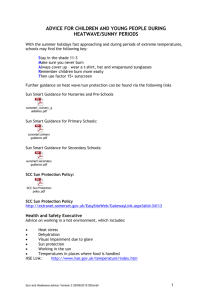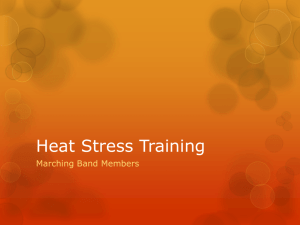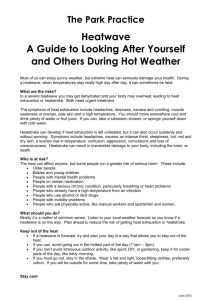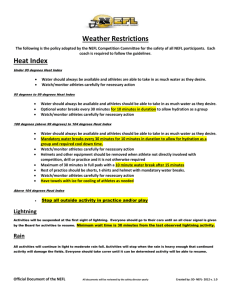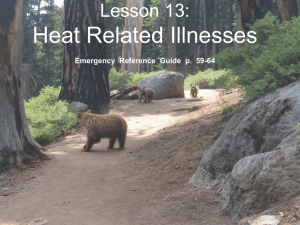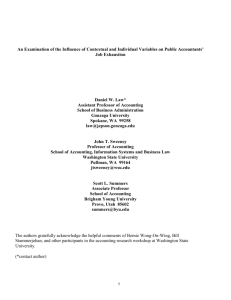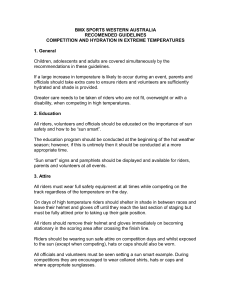Heatwaves
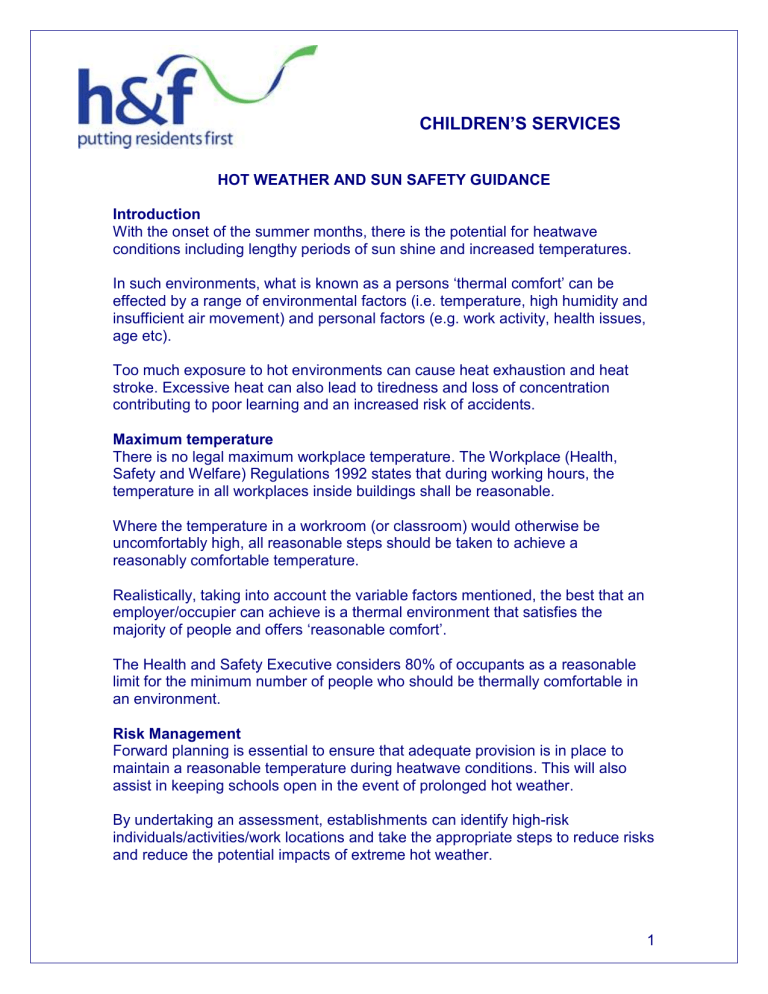
CHILDREN’S SERVICES
HOT WEATHER AND SUN SAFETY GUIDANCE
Introduction
With the onset of the summer months, there is the potential for heatwave conditions including lengthy periods of sun shine and increased temperatures.
In such environments, wh at is known as a persons ‘thermal comfort’ can be effected by a range of environmental factors (i.e. temperature, high humidity and insufficient air movement) and personal factors (e.g. work activity, health issues, age etc).
Too much exposure to hot environments can cause heat exhaustion and heat stroke. Excessive heat can also lead to tiredness and loss of concentration contributing to poor learning and an increased risk of accidents.
Maximum temperature
There is no legal maximum workplace temperature. The Workplace (Health,
Safety and Welfare) Regulations 1992 states that during working hours, the temperature in all workplaces inside buildings shall be reasonable .
Where the temperature in a workroom (or classroom) would otherwise be uncomfortably high, all reasonable steps should be taken to achieve a reasonably comfortable temperature.
Realistically, taking into account the variable factors mentioned, the best that an employer/occupier can achieve is a thermal environment that satisfies the majority of people and offers ‘reasonable comfort’.
The Health and Safety Executive considers 80% of occupants as a reasonable limit for the minimum number of people who should be thermally comfortable in an environment.
Risk Management
Forward planning is essential to ensure that adequate provision is in place to maintain a reasonable temperature during heatwave conditions. This will also assist in keeping schools open in the event of prolonged hot weather.
By undertaking an assessment, establishments can identify high-risk individuals/activities/work locations and take the appropriate steps to reduce risks and reduce the potential impacts of extreme hot weather.
1
It may be that some of the required control measures have budgetary implications. When considering what control measures can be utilised, costbenefit will need to be taken into account.
It should be borne in mind that extreme hot weather events tend to last for a few weeks of the year and as such, any controls introduced should be proportionate to the risk.
To prepare for extreme hot weather events, establishments can also produce a
‘hot weather plan’ detailing what action should be taken during these periods. It is important that establishments know when to implement such a plan. Local weather forecasts will give an indication if extreme hot weather is on the way.
All members of staff should be familiar with the plan and their role in implementing it.
Further information can be found at: www.hse.gov.uk/temperature/index.htm
and www.nhs.uk/Livewell/Summerhealth/Pages/Heatwave.aspx
Controlling Indoor Hazards
The following are some suggested measures that may be taken:
RISK FACTOR
Heat Source:
1) Sun entering and heating a room
2) Additional heat sources in rooms
Environmental: Air Temperature
1) High ambient air temperature
POSSIBLE CONTROLS
Stop sun/heat entering the room by:
Keeping lights off, if possible
Using blinds (Venetian or slatted blinds allow light in, while keeping sun rays out)
Reflective film on windows
Intelligent glazing systems
Moving workstation away from direct sunlight
Overhangs or awnings outside windows
Insulation - the material acts as a barrier reducing heat flow
Insulating hot pipes or equipment
Curtailing heat-generating activities e.g.use of computers,
Bunsen Burners, ovens etc
Decrease air temperature by:
Providing portable airconditioning
Providing fixed air-conditioning
2
Environmental: Air Movement
1) Lack of air movement
Environmental: Physical
1) Room retains heat
Improve air movement* by:
Ensuring windows can be easily opened
Ensuring windows are open
Providing fans - wall or ceiling mounted are better
Improve physical conditions by:
Relocating classes to cooler areas
Working outside in shaded areas
Rotating use of hot rooms
Task or Activity
1) Task is strenuous in nature
2) Lack of breaks during task
3) Task requires protective clothing
Individual
1) Person has medical condition
2) Person is elderly
3) Person is very young
Information and Training
1) No awareness of thermal comfort issues
Amend the task being undertaken by:
Avoiding strenuous activities or amending the task
Restricting the length of time people are exposed to hot conditions
Arranging for extra breaks to let people cool down
Arrange for school to start earlier and finish earlier
Protect the individual by:
Providing regular drinking water in classrooms
Relaxing dress codes
Providing surveillance for those with medical conditions
Regularly checking on children’s well-being
Improve staff and pupil awareness by:
Informing staff of signs and symptoms of heat stress and treatment, hot weather plan procedures etc
Informing pupils of what they should do (e.g. plenty of fluids, dress codes etc)
* Under the Education (School Premises) Regulations 1999 all occupied areas in a school building should have controllable ventilation at a minimum rate of 3 litres of fresh air per second for each of the maximum number of persons the area will accommodate.
3
All teaching accommodation, medical examination or treatment rooms, sick rooms, isolation rooms, sleeping and living accommodation shall also be capable of being ventilated at a minimum rate of 8 litres of fresh air per second for each of the usual number of people in those areas when such areas are occupied.
Sun Safety
During term time, children and adults can be found in an outdoors environment during the peak UV hours. Most skin cancers are caused by UV radiation from the sun. It is estimated that people get around 80% of their sun exposure by the age of 21. Much of this exposure occurs when at school.
SunSmart is the national skin cancer prevention campaign run by Cancer
Research UK . Schools can become more ‘SunSmart’ by:
developing their own school sun protection policy
incorporating sun protection into the school curriculum
making sure they provide sufficient shade in the school grounds
warning staff and parents about the dangers of too much sun
having in place suitable control measures
Further information is available from: www.sunsmart.org.uk
Controlling Outdoor Hazards
The following are some suggested measures that may be taken:
RISK FACTOR
Environment:
1) Lack of shade
Task:
1) Strenuous activities
2) Too much time in the sun
Individual:
1) Dehydration
2) Sunburn
3) Sunstroke
POSSIBLE CONTROLS
Reduce sun exposure by:
Creating shady areas using trees, awnings, overhangs, parasols etc
Reduce risk by:
Restrict activities outside between 11am-3pm
Reduce strenuous activities or carry out at cooler times
Arranging extra breaks to allow people to cool down
Increase morning break and reduce lunch break
Reduce risks by:
Providing access to drinking water
Ensuring pupils and staff wear wide brimmed sun hats
Relaxing dress code (allow loose, light coloured clothing
4
Training and Information:
1) No awareness of sun safety that covers neck and shoulders etc)
Improve awareness by:
Incorporating sun protection into curriculum
Promoting sun protection to pupils via assemblies, workshops, talks
Training teachers in the importance of sun protection
Informing parents of the importance of sun protection
Sunscreen is the last line of defence but can be useful for covering exposed areas of skin when shade and protective clothing are not practical e.g. during outdoor swimming, PE lessons and school excursions. Letters should be sent home asking for parental permission for teachers to supervise application of sunscreen
Heat Exhaustion and Heat Stroke
Heat exhaustion and heat stroke are caused by the body becoming dehydrated and over heated. This can lead to permanent damage to the body (including brain damage) and can even be fatal.
Signs of heat exhaustion include, headaches, nausea, dizziness, muscle weakness and cramps, pale skin and high temperature. Where heat exhaustion is diagnosed the individual should drink water and be cooled.
Heat stroke has similar symptoms but may also cause confusion and aggression, convulsions and unconsciousness.
Heatstroke requires urgent treatment. Call 999 immediately. While waiting for the ambulance, move the person to a cool place if possible, or to a well ventilated area, if possible opening windows or using a fan. Give them water or fruit juice to drink, and loosen and dampen their clothing or a cool, damp sheet.
5
